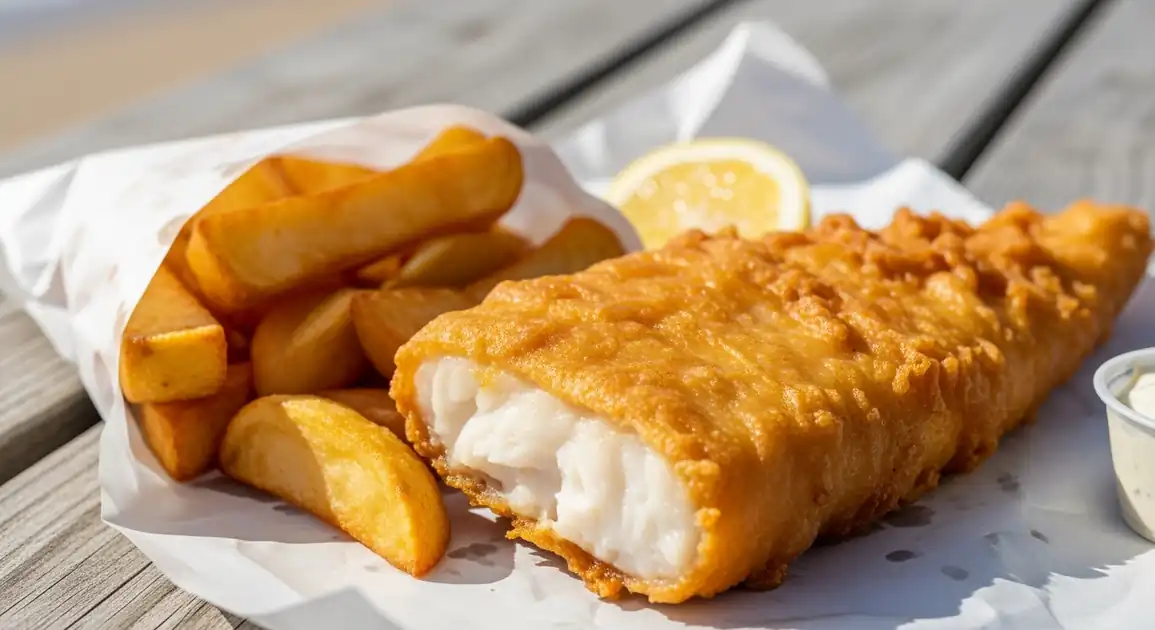Fish and Chips
Fish and Chips

Description
Auckland, with its extensive coastline and large population, has a huge number of fish and chip shops, ranging from basic suburban takeaways to more gourmet offerings. Competition keeps standards relatively high, particularly regarding fish freshness. Finding a good spot near one of the city's many beaches is a classic Auckland experience.
Dietary Information
Serving information
Serving style
Typically served wrapped in white paper. Many shops near parks or beaches are geared for takeaway to be eaten outdoors. Tartare sauce and lemon wedges are common additions, often costing extra.
Quick facts
Generally 11 AM - 8 PM or 9 PM, with many opening later on Fridays and Saturdays. Some may close mid-afternoon.
Safety Tips
What to Look For
-
Fish cooked fresh to order
Ensures the fish is hot, crispy, and hasn't been sitting, reducing bacterial risk and maintaining quality.
-
Hot, clean-looking cooking oil
Oil should be hot enough to cook quickly and seal the food. Avoid shops using very dark, dirty, or smoking oil which affects taste and safety.
-
Clean premises and food handling
A tidy shop with staff practicing good hygiene (using tongs, clean surfaces) is a positive sign.
-
Crispy, golden batter/crumbing
Indicates proper cooking temperature and technique. Avoid soggy or pale-looking fish.
-
Busy shop with high turnover
Suggests ingredients are likely fresh due to frequent restocking.
What to avoid
-
Pre-cooked fish sitting under heat lamps
Fish quality degrades quickly, becoming dry or soggy, and holding food at warm temperatures increases risk.
-
Excessively greasy product
Can indicate oil wasn't hot enough or the food wasn't drained properly. Ask for it to be well-drained.
-
Shop with visibly dirty counters, floors, or equipment
Poor general cleanliness can indicate broader hygiene issues.
-
Fish or chips that look undercooked or burnt
Improper cooking can affect both taste and safety (undercooked) or introduce burnt flavours.
Price information
Price range
Budget tips
- Look for shops in less central suburbs for potentially lower prices.
- Hoki remains a good budget fish choice.
- Share a scoop of chips – portions are often large.
- Check local noticeboards or online for specials.
Value indicators
- Fresh fish, often Snapper or Tarakihi, cooked well.
- Crispy, non-greasy batter and chips.
- Efficient service even when busy.
- Clean premises, especially visible cooking areas.
Where to Find This Dish
Mission Bay / St Heliers
Classic Eastern Beach suburbs with several popular shops catering to beachgoers.
Mission Bay Fountain, St Heliers Bay Village
Weekend Lunchtime, Summer Evenings
Mount Eden / Epsom
Well-regarded local shops in central suburbs known for quality.
Mount Eden Village, Greenwoods Corner
Evening (esp. Friday/Saturday)
North Shore Beaches (e.g., Takapuna, Browns Bay)
Numerous options along the North Shore coastline, popular with local families.
Takapuna Beach, Browns Bay Beachfront
Weekend Lunch/Evening
Wynyard Quarter / Viaduct Harbour
More upscale seafood restaurants offering plated fish and chips, plus some dedicated high-end takeaway spots.
Auckland Fish Market, Silo Park
Lunchtime, Evening
Vendor Tips
- Snapper is very popular in Auckland; ask if it's fresh.
- Parking can be tight near popular beach shops during peak times.
- Some central/upscale places might offer grilled fish as an alternative.
- Check recent online reviews (e.g., Google Maps) for current feedback on quality.
How to Order
Regional Variations
-
Gourmet Fish and Chips
(Gourmet Fish and Chips)
Some Auckland eateries offer elevated versions with craft beer batters, hand-cut chips, artisanal tartare sauces, and premium fish choices, often at a higher price.
-
Availability of Raw Fish (Ceviche)
(Ika Mata / Raw Fish Salad)
While not fried, some seafood shops or more Polynesian-influenced takeaways might sell raw fish salad alongside cooked options – a different local seafood experience.
-
Wider range of 'Extras'
(Extras)
Auckland shops often have extensive menus including spring rolls, curry rolls, crab sticks, dim sims (influenced by diverse population), alongside standard fritters and sausages.
Cultural context
History
Originating in the UK, fish and chips were brought to New Zealand by British settlers and quickly became a cheap, accessible, and popular meal, particularly for the working class. Its popularity soared through the 20th century, becoming synonymous with casual Friday night dinners, summer holidays, and eating by the beach. Local fish species and preferences shaped the distinct Kiwi style of fish and chips.
Local significance
A cornerstone of casual Auckland dining, intrinsically linked to beach culture and relaxed social gatherings. Represents an affordable treat for many families.
Eating customs
- Best eaten hot and fresh, often finding a spot with a view.
- Sharing is common.
- Defending your chips from seagulls at the beach is a common (and sometimes frustrating) experience!